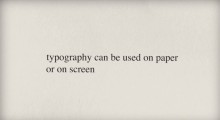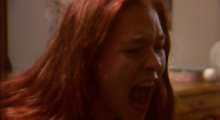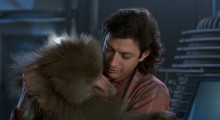6303 Results for “Open ”
-
Lucy: The Hyena Montage Theory

In a statement published in the Nov. 24, 1962 Film Culture, Pier Paolo Pasolini thought about how a simple metaphor can be conveyed onscreen, starting from one solution he rejected as overall unsound: “Let us consider the following written or spoken statement: ‘Gennarino looked like a hyena.’ […] The attempt has been made to juxtapose a hyena with Gennarino by joining two frames: one showing Gennarino grinding his teeth and the other showing an actual hyena with its teeth bared. Now, I won’t say that something like this could never be done legitimately. But it would be inconceivable to think […]
by Vadim Rizov on Jul 28, 2014 -
Watch: “From Paper to Screen,” Two Minutes about On-screen Typography

A hat-tip, as usual, to David Hudson at Keyframe Daily for directing us to this graduate student short from Thibault de Fournas. In a brisk two-plus minutes, Thibault first explains the art of typography on the printed page — size, style, type, forms — then concisely summarizes the history of type’s on-screen presence, from its introduction as static intertitles to the opening credits innovations of Saul Bass. The short summons memories of a century of movies through letters that copy source fonts exactly: “Every single movie got one,” says a sentence about opening credits, each word in the style of […]
by Vadim Rizov on Jul 28, 2014 -
Screening Abel Ferrara’s Director’s Cut of Cat Chaser

After Cat Chaser, Abel Ferrera was reluctant to give up final cut again, not without a fight anyways. The erotic thriller’s 1989 theatrical release, complete with a clunky voiceover ghosted by another actor because leading hunk Peter Weller refused, has a fundamentally different character from Ferrera’s director’s cut currently housed in the basement at Anthology Film Archives. Last Tuesday, Anthology screened the only known copy, on video with time code, a rough audio mix, and without a score, for the first time maybe ever since it played on the Fox lot to studio bigwigs in the ’80s. That’s the last […]
by Whitney Mallett on Jul 28, 2014 -
Happy Christmas Director Joe Swanberg on the Financial Life of the Independent Filmmaker

“Transparency benefits everybody.” That’s Joe Swanberg, whose recommended Happy Christmas opens today, talking about distribution dealmaking, but he might just as well have been talking about all aspects of his career and financial life. Indeed, Swanberg is nothing but transparent in this long interview with producer, director and ArtHome founder Esther Robinson focused specifically on making a living as a writer/director — precisely the subject most directors won’t issue a comment on. The interview was conducted for Robinson’s current piece in the new print edition of Filmmaker, “Still on the Job,” in which she revisits several directors featured in an […]
by Esther B. Robinson on Jul 25, 2014 -
Behaving Badly in Nathan Silver’s Stinking Heaven

I love being on set. Mine, yours, whomever’s. I like eating exorbitant amounts of food. I like idle conversation. I like the feeling you get when sleep deprivation kicks in and the dullest minutiae is suddenly hilarious. But mostly I like being around a group of people who have cast aside their better judgement to create something together. So when Nathan Silver asked if I wanted to come to the Stinking Heaven set, I gladly hopped the train to Passaic. I was excited to see how Nathan, who works from outlines and improvisation, constructs a film from the ground up. The following is a loosely timestamped diary […]
by Sarah Salovaara on Jul 25, 2014 -
Stray Links, 7/21-7/25

Starting this week, I’ll be posting a round-up of stray news items and articles — mostly film, though not all — that caught my eye. Let’s get started: • The great Michael Almereyda’s short film Skinningrove won the short film jury award at Sundance this year, and now you can watch it at the New York Review of Books. It’s about 15 minutes of photographer Chris Killip discussing and showing mostly unpublished photos of the titular Yorkshire village from the ’80s. • Here’s an interesting obituary for Thomas C. Senesac, owner of Chicago’s Acme Prop Rental, a company which got […]
by Vadim Rizov on Jul 25, 2014 -
Moog Synthesizers at the Movies: Deep Cuts

Over at the website of the Bob Moog Foundation, electronic music historian Thom Holmes has an interesting post about some lesser-known cinematic uses of the Moog, the pioneering analog synthesizer popularized by Wendy Carlos with 1968’s Switched-On Bach album, which introduced the public at large to the idea of electronic sounds as more than simple novelties. Carlos would go on to the soundtracks for A Clockwork Orange, The Shining and Tron, but many other movies in the ’60s and ’70s were quick to latch onto the instrument’s possibilities. Paul Beaver and Bernie Krause were among the Moog’s most productive practitioners […]
by Vadim Rizov on Jul 23, 2014 -
Transformers: The Asian American International Film Festival

Over the years, many New York-based media arts organizations and the film festivals they produce have folded, or scraped by in spite of outdated approaches and rigid programming. Asian CineVision and its offspring, the Asian American International Film Festival, on the other hand, have proven to be the little engines that could. The secret to their success: a keen awareness of shifts in the zeitgeist and talent pool, without losing sight of the Asian American community they serve (with a value added outreach to non Asian American communities). They are masters of reinvention. The 37th edition of the AAIFF (July […]
by Howard Feinstein on Jul 23, 2014 -
35mm Colors in Digital Translation in Boyhood

One aspect of Boyhood that’s been relatively underdiscussed (assuming there are any such left) is its use of 35mm, which has been widely noted but little parsed. Richard Linklater’s repeatedly noted that the primary reason for shooting on film over 12 years was to ensure visual continuity from one year to the next. This doesn’t mean he’s a Luddite in any way, as he explains in comments from a recent screening at the BFI on technology’s pros and cons: There is nothing more stable than a 35mm negative. Had I started on the best HD camera back in 2002, I’d […]
by Vadim Rizov on Jul 22, 2014 -
“Who the Hell is From Maine?”: Director Lance Edmands on Bluebird and Regional Specificity

I still have a Maine driver’s license, even though I’ve lived in Brooklyn for more than a decade now. When it comes up for renewal every few years, I travel back to the DMV in the town where I grew up and dutifully pose for a new photograph. People think this is crazy (and illegal) and I suppose they’re right, but it means a lot to me to be identified as a Mainer. When I get carded at a bar, the bouncer will take one look at my ID and inevitably say something like, “Maine? Who the hell is from […]
by Lance Edmands on Jul 22, 2014










